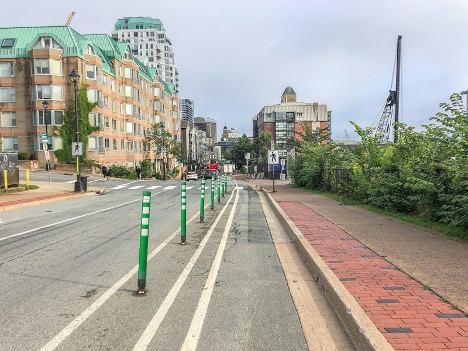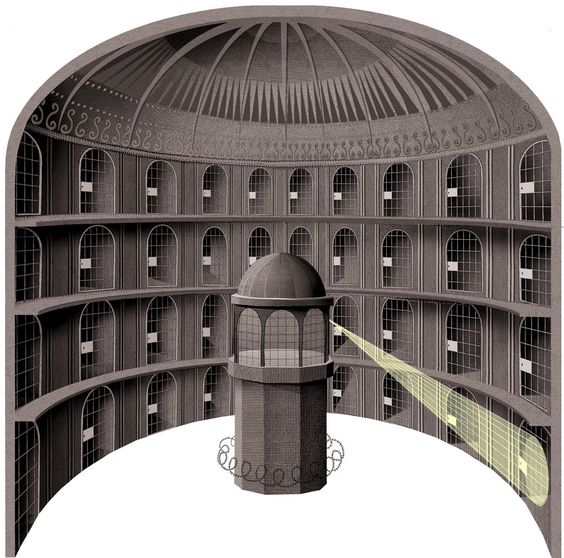Control by Design: Examining the Design of Digital Learning Environments

All designs, be it the design of buildings, the design of tools, or the design of technologies, assume and frequently impose certain expectations on how users will use the building, tool or technology. Designs offer varying degrees of flexibility or control in how they can be used. In the design of digital learning environments, instructors and administrators can often choose how much flexibility or control they wish to exert over learners through their choice of digital tools and how they use different features and settings within these tools.
Control of space is linked with control of social behaviour.
Temple (2014)
In this contribution, instructors and learning designers are asked to critically reflect on how the design of digital learning environments can explicitly or implicitly exert control over members of the learning community and to consider the impact that this control can have on the learner and the learning experience. Within this context, the design of the learning environment is seen as the functionality of the digital environment(s) or tool(s) used in constructing the learning experience combined with the decisions made by the instructor or administrators in designing the learning experience.
I first briefly examine the concept of hostile architecture, drawing from urban studies, then explore various control mechanisms in digital environments, asking learners to consider some specific examples of mechanisms of control in Learning Management Systems and reflect on how the design of these systems impacts both learners and instructors. Learners are invited to reflect on the control mechanisms they encounter in their own learning environments and the potential impact these have on the learning experience. I conclude, by provoking learners to consider the dualistic nature of designed control mechanisms as hostile towards some and desirable and beneficial to others. The goal is to help instructors and learning designers make judicious decisions on how much flexibility and control they embed within their learning designs.
Introduction to Hostile Architecture
Hostile Architecture is a term used in urban studies to refer to elements of architectural design that control how people use public spaces. Usually, hostile designs are intended to prevent or limit socially undesirable behaviour, such as laying down, camping, loitering, skateboarding, or using drugs. For example, in the following picture, metal barriers are preventing this person from sitting on the ledge, forcing him to choose the floor or not to sit at all. Hostile designs tend to have a larger impact on vulnerable groups, such as those experiencing homelessness, the disabled, the poor, youth, and racialized groups (Bader, 2020).
There is an important distinction between a law/rule and a hostile design. Consider the difference in performance between the sign and the rocks in the second image above. The sign discourages camping but does not inherently prevent it. The rocks make it physically impossible to pitch a tent. The sign is also very explicit about its intent, but the rocks could be perceived as a decorative feature of the landscaping. Hostile architecture in general tends to be what Savicic and Savic call ‘silent agents’ of control (Teo, 2018) meaning that it is not always transparent about how it is intending to control social behaviour.
Hostile design elements can include:
- Seating which prevents people from laying down or staying for extended periods of time by creating discomfort.
- Ledges that are designed with features that prevent undesirable use, such as loitering or skateboarding.
- Sounds used as a way to make spaces uncomfortable for individuals. One example in Toronto was the use of devices that emit high-pitched noises only audible to individuals under the age of 30.
- Lighting strategically designed to make spaces more uncomfortable or to otherwise prevent undesirable behaviour. One example is the use of blue lights in public spaces which are intended to discourage drug use because they make it more difficult to see veins.
- Barriers, including fences, walls, gates, bollards, locked doors or other design features intended to prevent or limit access.
- Surveillance technologies, such as cameras, which monitor behaviour and can be used as a psychological tool for controlling behaviour.
- Ghost Amenities, or the absence of certain features, such as seating, shelter, or public washrooms, which can prevent use of public spaces, particularly by vulnerable individuals who are in greater need of those amenities
Reflective Activity and Questions: Hostile Architecture Walking Tour
Hostile architecture is often disguised as creative or artful design. If you start paying attention, you will start to notice how common hostile designs are in urban spaces. Take a walk in your neighbourhood or on your campus. Look out for examples of hostile architecture – things that are designed in such a way to control human behaviour.
Reflect on the following:
- What is the hostile design?
- What behaviour is it trying to control?
- Whose behaviour is being controlled? And how?
Control Elements of Digital Spaces
Digital spaces are similarly prone to designs of control. In educational settings, Learning Management Systems (LMS) are one of the most ubiquitous types of education technologies – an LMS is a system designed, as suggested by the name, to manage learning. Common features of LMS include tools “for the administration, documentation, tracking, reporting, automation, and delivery of educational courses, training programs, or learning and development programs”(Wikipedia, n.d.). Essentially, an LMS is often presented as an all-in-one solution for controlling how information is presented and how and when learners can interact or engage in learning activities. As such, the LMS can be subject to many of the same designs of social control that impact physical spaces. This control may be inherent in the design of the actual system or may be the result of settings or decisions made by the instructor or course administrator.
Reflect on the following examples from courses designed in various LMS. For each example, consider the following questions:
- What behaviour is being controlled and how?
- How could this impact the learning experience or the learner-instructor relationship?
- Under what circumstances might this control be desirable?
- When might this control not be desirable and for whom?

Feedback: In this example, students are unable to respond to the announcement/post.

Feedback: In this example, timed access to the discussion forums is being used to ensure that students can only access the forums during a certain time.

Feedback: In this example, the student is unable to send a message to their classmates.
Reflective Activity and Questions: Digital Hostile Design
This time, you will take a tour through the digital spaces that you frequent, similarly looking for examples of hostile architecture. Consider how your behaviour is constrained by the design of the system.
- What are you able to do?
- What are you prevented from doing?
- How does this impact your experience in the space?
- How might this impact the design of learning experiences?
- How might this impact the student-teacher relationship?
Digital Surveillance as Hostile Architecture
Increasingly, surveillance technology is considered a form of hostile architecture. Surveillance technology is also increasingly pervasive in educational settings. One of the original designs of surveillance technology designed to control social behaviour was the panopticon – an idea conceived in the 18th Century by Jeremy Bentham and further developed by Michel Foucault. The concept was that by having a guard tower placed in the centre of a cell block, with bright, blinding lights pointed towards the cells, the prisoners would never know if the guards were looking at them. Thus, they would feel compelled to follow the rules and avoid any transgressions for fear of being punished.
Although this tool for psychological control was conceived within the penal system, a very similar approach to control via surveillance has developed within education. The use of surveillance technologies in education, such as plagiarism checkers, remote proctoring tools, and learning analytics, are on the rise (Watters, 2020).
Audrey Watters discusses the evolution of Surveillance Technologies in American schools in great detail. Surveillance tools are typically promoted as tools to ensure engagement and academic integrity, but, much like the panopticon, perform control in invisible ways.
Reflective Activity and Questions: Surveillance as Control
Consider the ways that students are surveilled in digital spaces.
- What surveillance tools or techniques have you seen being used in the digital spaces that you are familiar with?
- What are these tools supposed to do? Do they actually accomplish this?
- How might these surveillance tools control learner behaviour?
- Do these tools impact all learners in the same way?
Designed Control of Teaching Practice
Discussions of hostile architecture tend to focus on how design controls the most vulnerable groups. However, it is equally important to consider how the design and constraints of LMS and other education technologies impacts instructors and others in supposed positions of power. In instructional design, we must all be familiar with how our work is constrained by the design, functionality, and features of the systems that we use.
For example, many LMS are built upon a teacher-centered transmission model of teaching – the instructor acts as the administrator and controls the content, the flow of information, the communication, and most other aspects of the learning environment. By design, these systems can also force them to think about and approach teaching in specific ways. Instructors may have more control over the digital space than learners, but they do not have complete control. Tony Bates raises this issue when he discusses how the LMS prevents him from teaching in his desired way.
Reflective Activity and Questions: Hidden Messages about Teaching and Learning
Reconsider the digital learning spaces that you are familiar with.
- What implicit beliefs about teaching and learning are embedded in the design of LMS?
- How do LMS and other educational technologies impact teaching practices and the design of courses?
- How do the systems position the instructor? How do they position the student?
Is Control Always Hostile?
The word ‘hostile’ has negative connotations and is typically used as a critique of designs intended to control behaviour. However, in critically reflecting on how design can control behaviour, it is equally important to reflect on if and when designs of control may be desirable or acceptable.
Consider the following examples of bike lanes. In the first image, the lane is marked to indicate that it is a bike lane. In the second image, the lane is protected by bollards.

Based on our definitions above, the latter could be considered an example of hostile design – the presence of the bollards physically prevents drivers from entering the bike lane, thus preventing them from engaging in undesirable social behaviour (blocking the bike lane and endangering cyclists). The first design offers more freedom to drivers, but cycling communities strongly and vocally advocate for protected bike lanes. Should this be considered hostile?
Reflective Activity and Questions: Hostility or Benevolence
Think back to the designs that you identified earlier. Consider them again.
- Are all of the designs necessarily hostile?
- Are they hostile towards specific groups or individuals?
- Do they benefit any specific groups or individuals?
- When might designs of control in digital learning spaces be warranted or desirable?
Conclusion
It’s important when reflecting on this example to understand that most hostile designs are justified as safety measures and that all designs of control benefit some groups (Hidden Hostility DC, n.d.). The goal is not to encourage instructors and learning designers to avoid the use of control mechanisms entirely, but rather to help individuals recognize the impact and potential for harm of control mechanisms in their digital environments and to make informed decisions on their use of these control mechanisms in the design of learning experiences.
References
Bader, A. (2020). Hostile Architecture: Our Past, Present, & Future? CRIT(86), 48-51.
Hidden Hostility DC. (n.d.). Rationale for Defensive Architecture. Retrieved from Hidden Hostility DC: https://www.hiddenhostilitydc.com/rational
Temple, P. (2014). Preface. In P. Temple, & Temple (Ed.), The Physical University : Contours of space and place in higher education (pp. 212-232). New York, NY: Routledge. https://doi.org/10.4324/9781315813776
Teo, M. (2018, April 9). Unpleasant Design: The Rise of the Silently Hostile City. Retrieved from Azure: https://www.azuremagazine.com/article/unpleasant-design-hostile-architecture/
Watters, A. (2020, April 30). School Work and Surveillance. Retrieved from Hack Education: http://hackeducation.com/2020/04/30/surveillance
Wikipedia. (n.d.). Learning management system. Retrieved from Wikipedia: https://en.wikipedia.org/wiki/Learning_management_system#cite_ref-ellis_1-0



